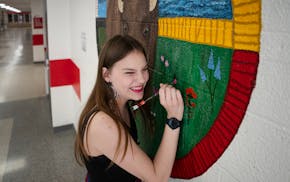The Green Line is in sore need of more green space, according to a report to be issued Wednesday that lays out a 10-year vision for creating both public and privately-funded parks near the light-rail line between St. Paul and Minneapolis.
The report, by the Trust for Public Land, proposes a unique concept — publicly accessible parks built and maintained by private owners — to help reach that goal.
And it also underscores the widely held belief that downtown Minneapolis, in particular, could use some additional greening.
The report, paid for by the Central Corridor Funders Collaborative, says that parks and green space foster economic development as well as healthful lifestyles.
"Hundreds of studies indicate that proximity to open space can increase values of property from 5 to 20 percent," the report states.
That open space can range from "signature parks" — often a downtown site that draws tourists and helps brand a city — to greenways or linear spaces, to privately owned public spaces such as plazas, gardens and small parks.
The report doesn't estimate the amount of money needed to create what it calls a "charm bracelet" of parks along the light-rail line, which runs 11 miles between the downtowns of Minneapolis and St. Paul.
It was intended not to quantify the investment but to "raise awareness," Trust program director Jenna Fletcher said. "We need to have many more green space amenities."
City officials, developers and community leaders worked with the Trust to produce the 33-page report, which Fletcher said will be used to guide developers and city planners as the Green Line corridor develops.
Parkland in both Minneapolis and St. Paul makes up 15 percent of land use, yet only 4.7 percent of the land along the Green Line corridor, which extends about a half-mile on either side of the tracks, according to the report.
With 17,000 additional households projected for the area in the next few years, it makes the argument that there's not nearly enough green space to handle future demand.
The report says corridor areas most in need of green space are downtown Minneapolis and the Midway neighborhoods in St. Paul.
"Downtown Minneapolis is seeing a huge influx of residents well underserved by green space," said David Frank, the city's transit-oriented development director.
In contrast, the University of Minnesota and downtown St. Paul are considered well served by parks — although even there, the report says, more green space will be needed to keep up with projected household growth.
Much of the report makes the case for privately owned park space, an idea that isn't new nationally but has never caught on in the Twin Cities.
"I think it's because we have such a great park system already," Fletcher said.
She added that some privately owned parks are "already in place," such as Bloch Cancer Survivors Park, a landscaped area fronting the former Federal Reserve Bank in downtown Minneapolis. "But there's not been a formal program, so it hasn't captured attention," Fletcher said.
Frank said the report shows that developers in high-demand areas should be encouraged to build open space, while public bodies should be prepared to step in and develop green space in slower markets.
Nancy Homans, St. Paul Mayor Chris Coleman's policy director, said that public parks alone won't turn the corridor green. She pointed out that Hamline Station, a nonprofit affordable housing development on the Green Line that started construction this week, will include a public plaza.
Parks are "not going to be a hard sell for big development sites," such as the proposed Snelling-University neighborhood marketplace and the Sears site near downtown, Homans said. "The harder ones will be the tiny lot redevelopment."
Kevin Duchschere • 651-925-5035

'No Mow May' eases to 'Less Mow May' in some Twin Cities suburbs

Centennial High School senior highlights Native American community in new mural
Remade Stillwater riverfront could bring new parks, boat launch, picnic space and fishing piers
Minnesotan's path from ISIS front lines to asset in war on extremism will be on display at sentencing

